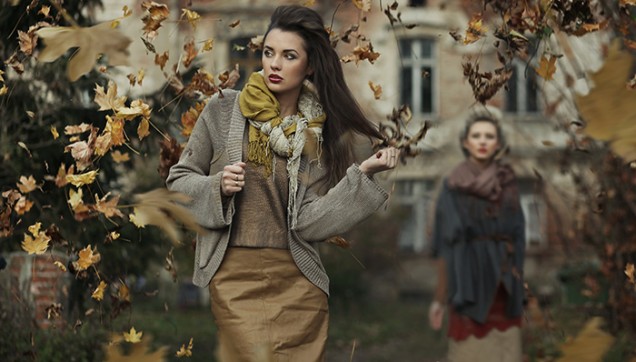People Attitues To Fashion
People have different attitudes to fashion. Some are indifferent – they do not care what they wear. Others, especially women, are very choosy and particular about what to wear and like to spend a lot of money on clothes. Some people buy ready-made clothes, others prefer to have them made to measure or buy them at second-hand shops. Some people have excellent taste in dress and are always dressed perfectly, others are slovenly in dress. There are some people who want to be dressed according to the latest fashion at all costs even if it does not suit them. It seems that it is a hobby for them to follow the fashion magazines and see what a few leading designers in Paris, Rome, London or New York present. For some people fashion is a matter of differentiation, the eagerness to distinguish oneself from one’s fellows. For others it is a need to match their ideal model by imitating his/her appearance.
The Factors That Have Influenced The Way Of Dressing
Different factors which have influenced the styles of clothing, such as geography, climate, poverty and wealth have played their role. We can also note how rich people altered their clothes with every fancy of their tailor while the poor people’s garments changed slowly. Then the cheap manufacture of cloth and the invention of the sewin g machine brought about a revolution. Ready-made clothes have become relatively cheap and now fashionable trends are imitated all over the world. On the other hand all of these facts resulted in a kind of uniformity. It is hard to tell the class, profession or even sex by the form of dress.
What Does Fashion Include?
Fashion concerns not only clothes, but also hair style, make-up and accessories, such as shoes, handbags, gloves, belts, hats, scarfs or jewellery and glasses. Clothing, footwear and cosmetics manufacturers as well as jewellery makers and hairdressers need to make money.
Styles, cuts, designs and particularly the length of clothes change very quickly because dressmaking has become a big business nowadays. Tight-fitting miniskirts may be in at one time, soon to be replaced by midcalf length and loose dress or maxi-style. Fashions often come back to older styles. What is out of fashion, funny or ridiculous now, may look romantic a few decades later. But the fashions never repeat themselves quite in the same way. There can be a whole range of distinctive features. We could note various types of neckline (high or low, oval, V-neck, boat neck, tie
or polo neck, with collar or collarless), and various cuts of sleeves (inset, raglan, dropped shoulder or batwing). The dress may have a classic line, A-line or be straight. The waistline may be natural, high or low. At one time straight or slit skirts are in, at another full, bell-shaped or divided skirts become trendy.
There is also a variety of materials the dress can be made of – traditional natural materials such as cotton, wool, linen, silk and the vast collection of new fabrics based on man-made fibres. But everybody usually looks for first class, washable, non-iron, crease- and shrink-resistant fabric. Their design can be plain or patterned (flowered, geometric, striped, checked, dotted or spotted) and taken from the whole spectrum of colours running from the brightest and most garish to the coolest and most subdued.
How Does The Season Influence Clothes?
The way we dress also depends on our taste, on the season and the proper occasion. We should know what kind of accessories complement to dress and what colours match each other. ln summer we wear light summer dresses, loose blouses with a low neckline and with short sleeves or without sleeves, skirts gathered at the waist or bell-shaped, cropped trousers, shorts or Bermuda shorts and various T-shirts. On our feet we pull on sandals, mules, slippers or plimsolls. When we go swimming we put on a swim suit (bikini, one-piece or two-piece) or trunks, sometimes a beach gown and a straw hat. In winter we need to wear something warm – suits, trousers, jeans, woollies, cardigans, polo neck sweaters, jumpers, anoraks and parkas, winter coats and jackets, sometimes even a fur coat, gloves and mittens, caps, hoods, hats, scarfs and mufflers. And boots of course.
Special Occasions
On special occasions we like to be dressed properly too. When we go to a concert or to the theatre we prefer to be dressed up. We wear an evening dress, which consists of a dark suit, a light shirt and a tie or a bowtie, sometimes a dinner jacket, an evening gown, court shoes and pumps. For sports we put on sports wear, such as jeans, shorts , T-shirts, blazers, parkas, track suits and to the mountains a waterproof jacket or anorak and sports shoes (trainers, plimsolls, heavy boots or skishoes). At home we like to feel comfortable, and so we prefer leisure wear – slacks, jeans and T-shirts and on our feet slippers or mules. To school we wear something practical and plain. The most favourite wear of teenagers include jeans or trousers, shirts and T-shirts of different colours, sweatshirts or pullovers and trainers. For workshop or cleaning jobs we must put on an apron, overall or overalls.
Special kinds of clothes are uniforms and costumes. Uniforms are worn particularly by professionals such as the police, the armed forces, health workers, sometimes workers of a certain firm. It is still a tradition in some schools in Britain (mostly private ones) to wear a school uniform. It usually consists of a white shirt and grey or dark trousers and a dark sweater or blazer with a school badge on the breast pocket and perhaps a cap (for younger boys). Unlike the boys who do not mind wearing uniforms because they do not differ very much from ordinary clothes, the girls complain about them and hate wearing them. A girl’s uniform looks quite different from an ordinary girl’s dress because it consists of a plain coat, a blouse and a skirt in some dark colour, such as grey, navy blue or brown. Girls would prefer ordinary clothes to express their personality or perhaps they just feel more comfortable in jeans and a T-shirt. The argument for uniforms is that they prevent competition among the girls and hide differences in family incomes.
Costumes on the other hand reflect the style of a past time. Apart from the theatre they are not seen very often, only on special occasions. Scotsmen are well-known for their national costume which consists of a kilt (a short skirt with many pressed pleats), knee-length woollen socks, a cap and a sporran (a fur-covered bag worn as a purse). The kilt is made of tartan, a kind of woollen cloth woven in stripes of various colours which cross at right angles so as to form a pattern. The difference is in the colours and the width of the stripes. Most tartans have either green or red as the dominant colour.
Fashion Changes
The fashion changes so fast that often we face the question of what to do with clothes which we do not need any longer. It is easy to discard worn-out clothes but what to do with unworn clothes which you do not like any more? People in the west often arrange jumble or garage sale but it is not a custom in our country yet. Some people store them up in their wardrobe if they have enough room, pass them down to somebody younger or give them to a charity organisation. Women who can do needlework (sew, knit, crochet or embroider) often remake an old dress and change it into a new stylish model which is admired by their colleagues as if it was bought in a boutique.
Some people do not choose their dress with regard to the latest fashion, they apply a wait-and-see attitude and wear what suits them, what is healthy and what they can afford. The most important thing is that such dresses are neat and clean, they look smart and elegant and they feel comfortable.

